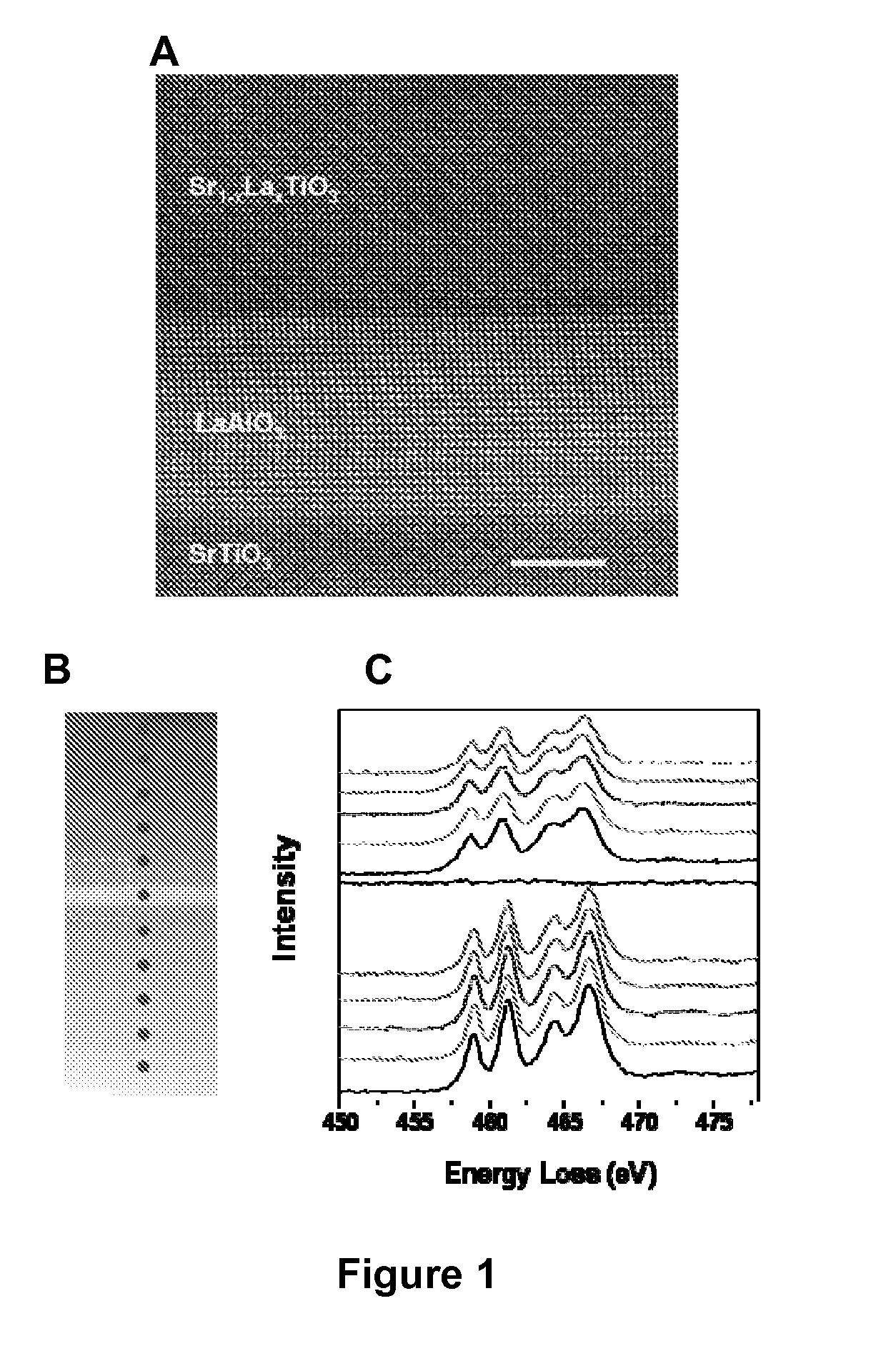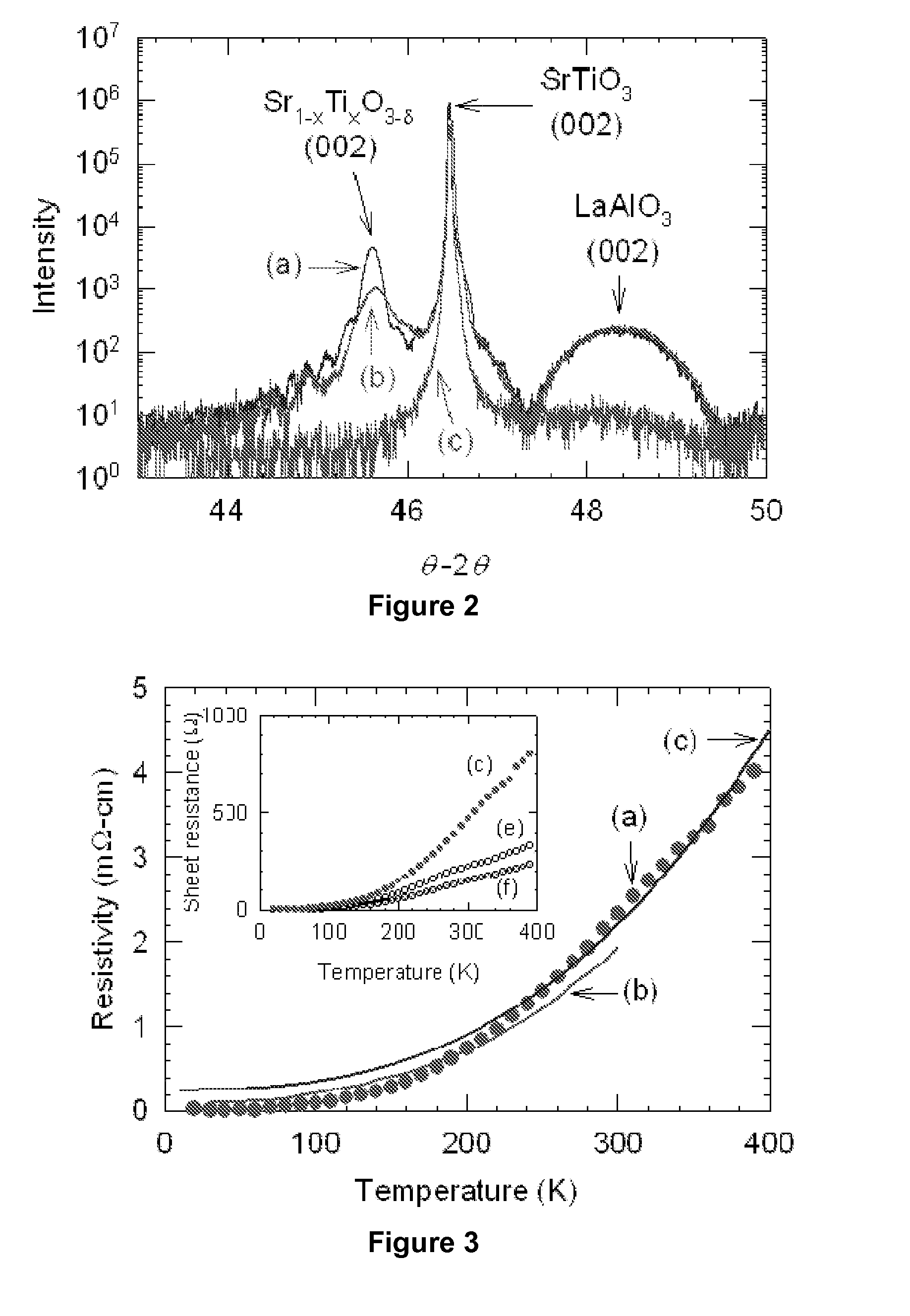Complex Oxides Useful for Thermoelectric Energy Conversion
a thermoelectric energy and complex oxide technology, applied in the direction of oxide conductors, non-metal conductors, thermoelectric device manufacture/treatment, etc., can solve the problems of insufficient conversion efficiency of current thermoelectric materials based on bismuth telluride and/or semiconductors, inability of current thermoelectric systems to become widely used, toxic and hazardous popular thermoelectric materials tellurium and bismuth
- Summary
- Abstract
- Description
- Claims
- Application Information
AI Technical Summary
Benefits of technology
Problems solved by technology
Method used
Image
Examples
example 1
[0050]SrTiO3 (STO) is a cubic perovskite (Pm3m) with a bulk lattice parameter of 3.9056 Å. Out-of-plane lattice parameters of the films were characterized via x-ray diffraction using a Panalytical X'Pert MRD Pro 4-circle diffractometer for θ-2θ and rocking curve (ω) scans. All SLTO films grown were slightly distorted (˜1%) with the c-axis measuring 3.946 Å for typical 100 nm thick films.
[0051]TEM characterization and electron energy-loss spectroscopy (EELS) were performed on an FEI Tecnai F20 equipped with a high-angle annular dark-field (HAADF) detector. The quasi-homoepitaxial films (αSLTO bulk=3.9057 Å) exhibited smooth surfaces and flat interfaces with the substrate, and maintained uniform thicknesses through the entire specimen. STEM EELS was performed across the SLTO / STO interface with an energy resolution of 0.7 eV.
[0052]In addition, RHEED pattern intensity oscillations of the STO 001 peak were visible throughout the growth of films to thicknesses of nearly 200 nm.
Targets, Su...
example 2
[0058]A laser molecular beam epitaxy (MBE) is used to deposit 50-nm-thick Lanthanum-doped SrTiO3 films from a target containing SrO, TiO2, and La2O3 on 5 mm×5 mm×500 μm single-crystalline SrTiO3 substrates with a 10-nm-thick LaAlO3 buffer layer. During the deposition, the substrate is kept at a temperature and a vacuum pressure of 450° C. and ˜10−7 Torr, respectively. The sample is cooled at about 10° C. / min and the pressure is maintained throughout the entire process. The laser energy density, the repetition rate, and the deposition rate are ˜1.6 J / cm2, and 1 Hz, respectively. The vacuum pressure is high enough to produce oxygen-deficient, Sr1-xLaxTiO3-δ (δ>0) films. The substrate is prepared by depositing a fully strained 10-nm LaAlO3 buffer layer on TiO2-terminated (001) SrTiO3 at 850° C. and ˜0.75×10−4 Torr. When the substrate is cooled after the LaAlO3 deposition, oxygen is purged into the chamber till atmospheric pressure. This minimize the oxygen vacancies that might be creat...
PUM
 Login to View More
Login to View More Abstract
Description
Claims
Application Information
 Login to View More
Login to View More - R&D
- Intellectual Property
- Life Sciences
- Materials
- Tech Scout
- Unparalleled Data Quality
- Higher Quality Content
- 60% Fewer Hallucinations
Browse by: Latest US Patents, China's latest patents, Technical Efficacy Thesaurus, Application Domain, Technology Topic, Popular Technical Reports.
© 2025 PatSnap. All rights reserved.Legal|Privacy policy|Modern Slavery Act Transparency Statement|Sitemap|About US| Contact US: help@patsnap.com



